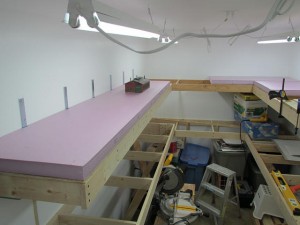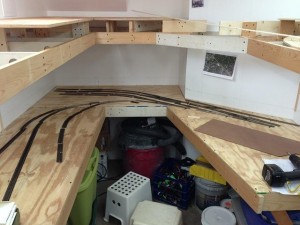My interest in the Georgetown Branch is twofold; to enjoy the research and history of the line and to also satisfy my modeling needs. The goal I have is to provide enough material so that I might make as accurate a representation as possible. So far I’ve gathered enough materials to give it a good go, but I have a long way to go, mainly needing to find time to work on the various modeling projects. Progress has been slow and steady over the last few years but a lot of it has been a learning experience. For example, building the open-frame benchwork and laying spline roadbed were both completely new to me. It has been fun, and isn’t that what model railroading is all about?
Note – most of my recent and ongoing progress updates for the layout will be found right here on this blog. Visit the main page and search for “layout”.
Layout At A Glance
Prototype: Georgetown Branch of the Baltimore and Ohio (B&O) Railroad
Locale: Washington, DC and western suburbs
Period: Winter/Fall (TBD)
Era: 1945-1955. Allow the use of both steam and diesel. Allow some prototype design elements/buildings/track configurations to exist and others to be omitted. (eg. Whitehurst Fwy.)
Scale: HO
Layout Size: 19.25′ x 6.5′ (main room) plus external staging yard and helix.
Benchwork: Open grid, plywood cookie-cutter.
Roadbed: Homabed, Homasote, Cork.
Track: Micro Engineering & Walthers/Shinohara Code 83, Atlas Code 100 in staging.
Turnouts: #6 Micro Engineering, hand laid, and Peco #10.
Mainline Run: TBD
Maximum Grade: TBD
Minimum Radius: 19.5″ on helix, 22″ on mainline curves
Power & Control: Digitrax DCC
Backdrop: Painted Masonite and drywall.
Scenery: TBD
Construction
It is an HO scale around-the-room double deck shelf style layout. Single track mainline with one small staging area. Focus points of the layout include Georgetown Junction (where the Branch met the Metropolitan Branch), Chevy Chase, Bethesda, Dalecarlia and the Georgetown waterfront where the most complex switching will be found. I’m using code 83 track with Homabed roadbed and splines and plywood subroadbed. There is a 19.5″ radius / 2.9% grade helix which connects the two levels. On the mainline, curves are no sharper than 22″ radius. Wired using Digitrax DCC with no signals. Turnouts will be thrown with a combination of servo motors, manual and hand throws.
Operations
The era is 1945-1955. I will operate mainly medium to small steam locos and first generation and early diesel engines. Train car lengths will be no more than 10-12 cars. The GB will operate with up to three trains; The Met local to do switching at the Junction, the Georgetown Turn to switch the branch, and the Georgetown Switcher, a dedicated unit which lives down on the waterfront. Industries served include commodities such as lumber, metals, fuel (coal, oil), auto parts, aggregates, machinery, paper, flour, foodstuffs, general freight and merchandise. The Branch saw no real passenger traffic but there will be an excursion train or two from time to time.
Scenery
The setting will likely be Fall/Winter or perhaps very early Spring. (as of 2022, this is not yet decided). The GB has a very varied landscape for such a short branch, which is one of the reasons I’m so attracted to it. Some of the highlights include a mainline interchange, an 85′ high wooden trestle across a creek, a long brick-lined tunnel, crossing of an active trolley line, three bridge spans across the C&O Canal, running alongside the Canal, and industrial waterfront street running along the Potomac river.
Colors will be toned down, well-weathered and as accurate as I can be. I hope to focus my modeling efforts in a few areas to recreate some of the key scenes and iconic structures along the line.
Photos of my progress can be viewed in the Gallery and on this blog.


great layout, and looking forward to seeing your progress!
Hope you’re progressing. Great stuff!
Prior to the late sixties / early seventies acquisition of the Brockway 9 yd mixers,
the 7 yd mixer that is shown and all the other prior trucks were all painted a military green but not as dull